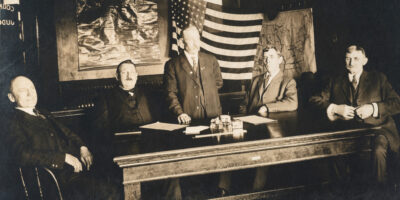4,000 Years of Failed Price Controls

Reprinted from the Foundation for Economic Education
In 1892 the French archaeologist Henri Pognon made a historic discovery a few dozen miles northeast of Baghdad: a massive tell that held the ruins of the ancient city-state Eshnunna.
Though it was not excavated until decades later by another archaeological team led by Dutch Egyptologist Henri Frankfort, the tell was one of the great finds of the century, revealing secrets of a Mesopotamian city that had been hidden for millennia.
Among the secrets discovered on cuneiform tablets was that Eshnunna used price controls, a discovery notable in that it appears to be the oldest historical record of humans fixing prices. (I’ve attempted to verify this fact with economic historians, and will let you know if I get a response.)
1 kor of barley [she’um] is (priced) at [ana] 1 shekel of silver;
3 qa of “best oil” are (priced) at 1 shekel of silver;
1 seah (and) 2 qa of sesame oil are (priced) at 1 shekel of silver. . . . The hire for a wagon together with its oxen and its driveris 1 massiktum (and) 4 seah of barley. If it is (paid in) silver, the hire is one third of a shekel. He shall drive it the whole day.
Eshnunna’s price controls edge out by a couple centuries the Code of Hammurabi (1755–1750 BC), a more famous record from ancient Babylon that was a “maze of price control regulations,” as the historian Thomas DiLorenzo put it.
This might explain why the First Babylonian Empire fizzled nearly a thousand years before the Greek poet Homer told the story of the Trojan War. Price controls don’t work, and an abundance of history (as well as basic economics) proves it.
A Brief History of Price Controls
The Ancient Greeks may have given us Homer and his wonderful stories, but they suffered from the same economic ignorance as the rulers of Eshnunna when it came to price fixing.
In 388 B.C., grain prices in Athens were out of control—largely because Athenian rulers had an incredibly complex set of regulations on agriculture production and commerce, which included “an army of grain inspectors appointed for the purpose of setting the price of grain at a level the Athenian government thought to be just.” The penalty for evading these price controls was death, and many grain traders soon found themselves on trial facing such a punishment when it was discovered they were “hoarding” grain during a (man-made) shortage.
The Athenian Empire was history by the time Rome attempted its own price control scheme seven hundred years later on a much larger scale. In 301 A.D. the Emperor Diocletian passed his Edict on Maximum Prices, which set a fixed rate on everything from eggs and grain to beef and clothing and beyond, as well as the wages of laborers who produced these items. The penalty for anyone caught violating these edicts was—you guessed it—death. Traders responded exactly as one would expect to these regulations.
“The people brought provisions no more to market, since they could not get a reasonable price for them,” one historian wrote. Not coincidentally, Rome’s empire soon went the same way as that of the Athenians (though the eastern half would survive another thousand years).
And then there’s the British colony of Bengal, located in northeast India. Few people today remember the Bengal Famine of 1770, which is astonishing considering an estimated 10 million people died, roughly a third of its population. What’s even more astonishing is how little attention the event attracted at the time, at least in the London press. While many attributed the famine to the monsoons and drought that plagued the region in 1768 and 1769, Adam Smith, writing in The Wealth of Nations, correctly observed that it was the price controls that came afterwards that likely turned a scarcity of food into a full blown famine.
“The drought in Bengal, a few years ago, might probably have occasioned a very great dearth. Some improper regulations, some injudicious restraints, imposed by the servants of the East India Company upon the rice trade, contributed, perhaps, to turn that dearth into a famine.
When the government, in order to remedy the inconveniencies of a dearth, orders all the dealers to sell their corn at what it supposes a reasonable price, it either hinders them from bringing it to market, which may sometimes produce a famine even in the beginning of the season; or, if they bring it thither, it enables the people, and thereby encourages them to consume it so fast as must necessarily produce a famine before the end of the season.”
And let us not forget the French Revolution, where in 1793 leaders paused their head-lopping to pass the Law of the General Maximum, a set of price controls passed to limit “price gouging.” (Henry Hazlitt had it right when he called the law “a desperate attempt to offset the consequences of [the leaders’] own reckless overissue of paper money.”)
The American historian Andrew Dickson White (1832-1918), a cofounder of Cornell University, explained the consequences of the policy.
“The first result of the Maximum [price law] was that every means was taken to evade the fixed price imposed, and the farmers brought in as little produce as they possibly could,” White wrote. “This increased the scarcity, and the people of the large cities were put on an allowance.”
Important Market Signals
Fortunately, today we have the advantage of not just history but the science of economics to show us that price controls don’t work.
Basic economics teaches that prices are important market signals. High prices might be an aggravation for consumers, but they signal to producers the opportunity for profit, which leads to more production and investment. They also signal to consumers that the good is scarce, which encourages people to use less of it.
Take gasoline. When prices are $7.50 a gallon, people drive less than they would if the price were $1, $3, or $5 per gallon. Meanwhile, the high price also signals to producers an opportunity for profit, which encourages investment and production, which ultimately leads to lower gasoline prices. As economists will sometimes say, the solution to high prices is high prices.
Putting an artificially low price on gasoline sends the wrong signals to both consumers and producers. The low price discourages producers from bringing fuel to market, and it also encourages consumers to use more fuel because it’s artificially inexpensive—which is a recipe for a gas shortage.
This is precisely what happened in the 1970s after President Nixon announced price controls on gasoline, resulting in a sustained national shortage and massive gas lines. (For what it’s worth, Nixon knew his price controls would be a disaster, but passed them anyway because it would signal to voters he “meant business.”)
Price Controls Are Back
Today nearly all economists agree that price controls are harmful—yet this has not stopped the specter of them from rising once again during our current global economic turmoil.
As Axios recently reported, price controls are back and are no longer a relic of the 70s. Facing an energy crisis, G-7 countries are seeking to form a buyers cartel that would effectively put a price cap on Russian crude oil.
The scheme, like all price control schemes, is likely to backfire. An abundance of evidence shows price fixing produces little beyond scarcity, black markets, and—in worst case scenarios—death and famine.
The people of ancient Eshnunna can be forgiven for not understanding why setting the price of a kor of barley at a shekel of silver was a harmful policy.
Today’s policymakers, who have the benefit of history and economics, have no excuse.










